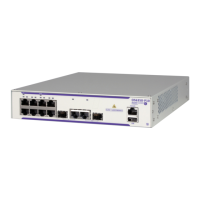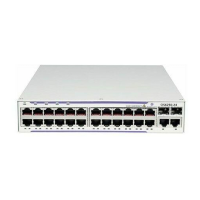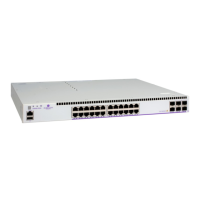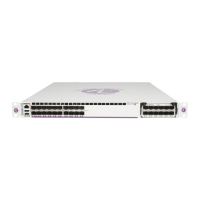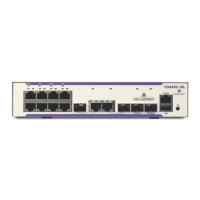Configuring BFD Configuring BFD
OmniSwitch AOS Release 8 Network Configuration Guide December 2017 page 20-19
-> show ip bgp
Admin Status = disabled,
Operational Status = down,
Autonomous System Number = 1,
BGP Router Id = 0.0.0.0,
Confederation Identifier = 0,
IGP Synchronization Status = disabled,
Minimum AS Origin Interval (seconds) = 15,
Default Local Preference = 100,
Route Reflection = disabled,
Cluster Id = 0.0.0.0,
Missing MED Status = Best,
Aspath Comparison = enabled,
Always Compare MED = disabled,
Fast External FailOver = disabled,
Log Neighbor Changes = disabled,
Multiple Paths = disabled,
Graceful Restart = enabled,
Graceful Restart Status = Not Restarting,
Configured Graceful Restart Interval = 90s,
IPv4 Unicast = enabled,
IPv6 Unicast = disabled,
BFD Status = disabled
ASN Output Format = asplain
2 Once BGP is registered with BFD at the protocol level, you need to enable BFD for particular IPv4 or
IPv6 BGP neighbors using the ip|ipv6 bgp neighbor bfd-state command as shown below:
-> ip bgp neighbor 135.10.10.2 bfd-state enable
-> ipv6 bgp neighbor fe80::2efa:a2ff:fe13:e402 bfd-state enable
The above commands enable BFD for a neighbor with IPv4 address 135.10.10.2 and a neighbor with IPv6
address fe80::2efa:a2ff:fe13:e402. To enable BFD for all BGP neighbors (IPv4 and IPv6), use the ip bgp
bfd-state all-neighbors command as shown below:
-> ip bgp bfd-state all-neighbors enable
To disable BFD for all configured BGP neighbors, use the ip bgp bfd-state all-neighbors with the
disable keyword, as shown below:
-> ip bgp bfd-state all-neighbors disable
To display the BFD status of IPv4 BGP neighbors, use the show ip bgp neighbors command. For
example:
-> show ip bgp neighbors
Legends: Nbr = Neighbor
As = Autonomous System
Nbr address As Admin state Oper state BGP Id Up/Down BFD Status
---------------+-----+-----------+------------+-----------+------------+---------
100.1.1.10 2 enabled established 3.3.3.3 00h:02m:19s enabled
192.40.4.29 3 enabled established 192.40.4.29 00h:14m:48s disabled
192.40.4.121 5 disabled idle 0.0.0.0 00h:00m:00s enabled
To display the BFD status of IPv6 BGP neighbors, use the show ipv6 bgp neighbors command. For
example:

